Estimating Report: Building Cost, Design and Pricing Analysis
VerifiedAdded on 2023/06/03
|7
|1508
|191
Report
AI Summary
This report provides a comprehensive analysis of construction estimating, focusing on a 40-story building project. It explores the effects of different design decisions, such as using precast facades and steel formwork, on building costs. The report details the cost estimation process, including schematic plans, elevation views, and site plans. It also examines the benefits of precast concrete and steel formwork. Furthermore, the report outlines pricing preliminaries, covering temporary office provisions, utilities, site safety, and transport services. It concludes by discussing the principles and methods for construction pricing, including information accuracy, integrity, uncertainty, and risk management, providing valuable insights for construction professionals and students alike. The report references key industry sources to support its findings.

Estimating 2 1
Estimating 2
Name
Institution Affiliation
City/State
Date
Estimating 2
Name
Institution Affiliation
City/State
Date
Paraphrase This Document
Need a fresh take? Get an instant paraphrase of this document with our AI Paraphraser
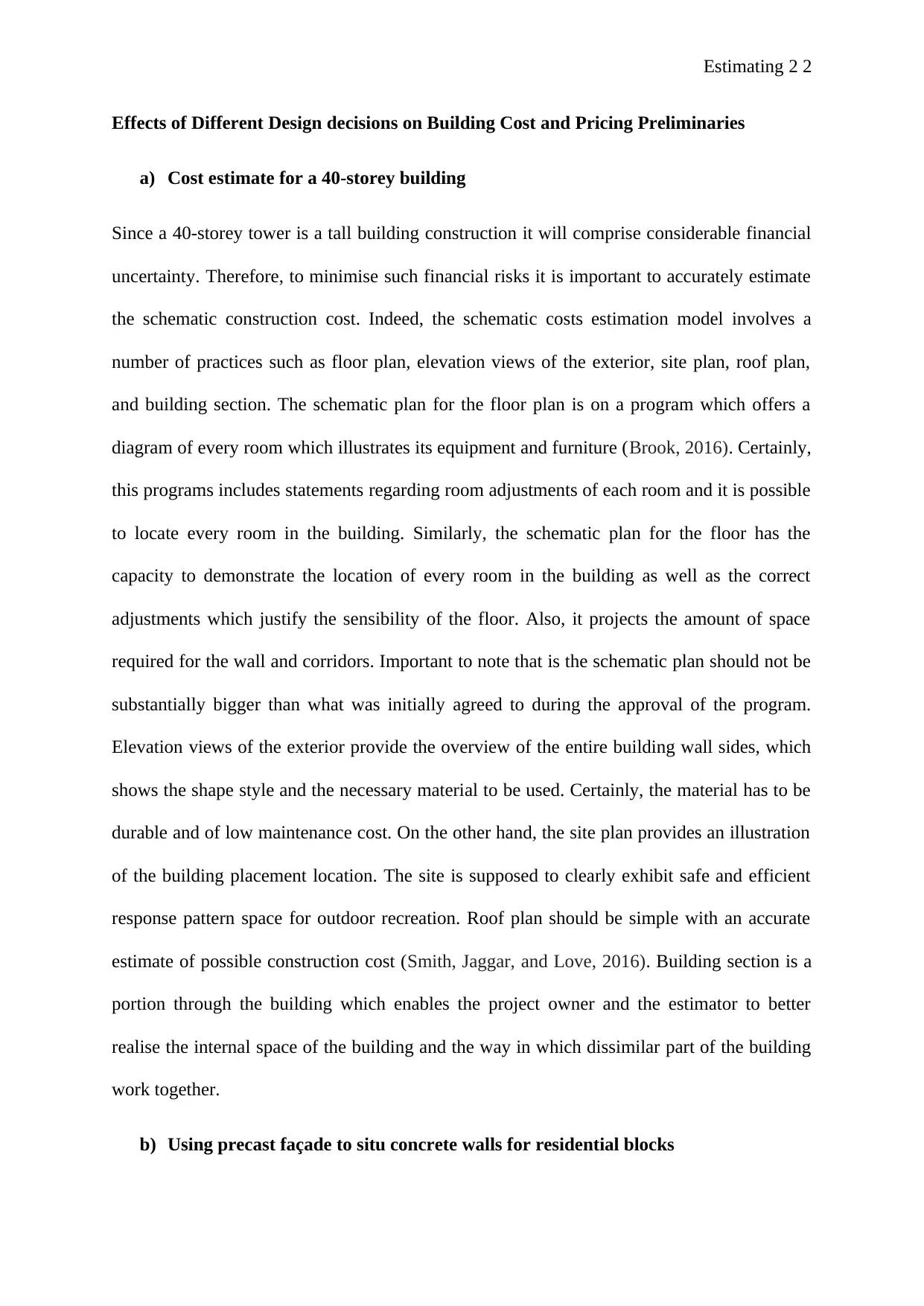
Estimating 2 2
Effects of Different Design decisions on Building Cost and Pricing Preliminaries
a) Cost estimate for a 40-storey building
Since a 40-storey tower is a tall building construction it will comprise considerable financial
uncertainty. Therefore, to minimise such financial risks it is important to accurately estimate
the schematic construction cost. Indeed, the schematic costs estimation model involves a
number of practices such as floor plan, elevation views of the exterior, site plan, roof plan,
and building section. The schematic plan for the floor plan is on a program which offers a
diagram of every room which illustrates its equipment and furniture (Brook, 2016). Certainly,
this programs includes statements regarding room adjustments of each room and it is possible
to locate every room in the building. Similarly, the schematic plan for the floor has the
capacity to demonstrate the location of every room in the building as well as the correct
adjustments which justify the sensibility of the floor. Also, it projects the amount of space
required for the wall and corridors. Important to note that is the schematic plan should not be
substantially bigger than what was initially agreed to during the approval of the program.
Elevation views of the exterior provide the overview of the entire building wall sides, which
shows the shape style and the necessary material to be used. Certainly, the material has to be
durable and of low maintenance cost. On the other hand, the site plan provides an illustration
of the building placement location. The site is supposed to clearly exhibit safe and efficient
response pattern space for outdoor recreation. Roof plan should be simple with an accurate
estimate of possible construction cost (Smith, Jaggar, and Love, 2016). Building section is a
portion through the building which enables the project owner and the estimator to better
realise the internal space of the building and the way in which dissimilar part of the building
work together.
b) Using precast façade to situ concrete walls for residential blocks
Effects of Different Design decisions on Building Cost and Pricing Preliminaries
a) Cost estimate for a 40-storey building
Since a 40-storey tower is a tall building construction it will comprise considerable financial
uncertainty. Therefore, to minimise such financial risks it is important to accurately estimate
the schematic construction cost. Indeed, the schematic costs estimation model involves a
number of practices such as floor plan, elevation views of the exterior, site plan, roof plan,
and building section. The schematic plan for the floor plan is on a program which offers a
diagram of every room which illustrates its equipment and furniture (Brook, 2016). Certainly,
this programs includes statements regarding room adjustments of each room and it is possible
to locate every room in the building. Similarly, the schematic plan for the floor has the
capacity to demonstrate the location of every room in the building as well as the correct
adjustments which justify the sensibility of the floor. Also, it projects the amount of space
required for the wall and corridors. Important to note that is the schematic plan should not be
substantially bigger than what was initially agreed to during the approval of the program.
Elevation views of the exterior provide the overview of the entire building wall sides, which
shows the shape style and the necessary material to be used. Certainly, the material has to be
durable and of low maintenance cost. On the other hand, the site plan provides an illustration
of the building placement location. The site is supposed to clearly exhibit safe and efficient
response pattern space for outdoor recreation. Roof plan should be simple with an accurate
estimate of possible construction cost (Smith, Jaggar, and Love, 2016). Building section is a
portion through the building which enables the project owner and the estimator to better
realise the internal space of the building and the way in which dissimilar part of the building
work together.
b) Using precast façade to situ concrete walls for residential blocks
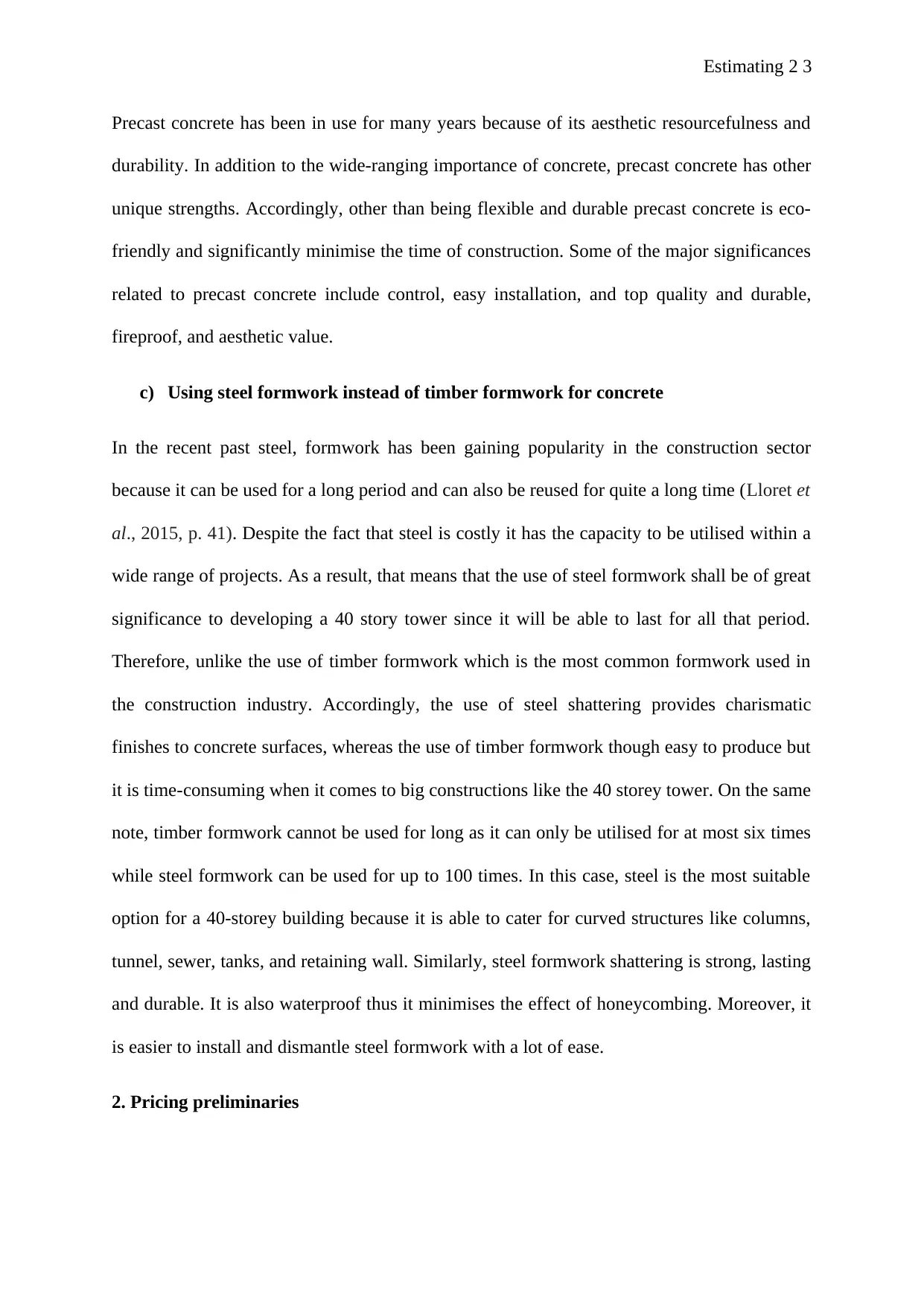
Estimating 2 3
Precast concrete has been in use for many years because of its aesthetic resourcefulness and
durability. In addition to the wide-ranging importance of concrete, precast concrete has other
unique strengths. Accordingly, other than being flexible and durable precast concrete is eco-
friendly and significantly minimise the time of construction. Some of the major significances
related to precast concrete include control, easy installation, and top quality and durable,
fireproof, and aesthetic value.
c) Using steel formwork instead of timber formwork for concrete
In the recent past steel, formwork has been gaining popularity in the construction sector
because it can be used for a long period and can also be reused for quite a long time (Lloret et
al., 2015, p. 41). Despite the fact that steel is costly it has the capacity to be utilised within a
wide range of projects. As a result, that means that the use of steel formwork shall be of great
significance to developing a 40 story tower since it will be able to last for all that period.
Therefore, unlike the use of timber formwork which is the most common formwork used in
the construction industry. Accordingly, the use of steel shattering provides charismatic
finishes to concrete surfaces, whereas the use of timber formwork though easy to produce but
it is time-consuming when it comes to big constructions like the 40 storey tower. On the same
note, timber formwork cannot be used for long as it can only be utilised for at most six times
while steel formwork can be used for up to 100 times. In this case, steel is the most suitable
option for a 40-storey building because it is able to cater for curved structures like columns,
tunnel, sewer, tanks, and retaining wall. Similarly, steel formwork shattering is strong, lasting
and durable. It is also waterproof thus it minimises the effect of honeycombing. Moreover, it
is easier to install and dismantle steel formwork with a lot of ease.
2. Pricing preliminaries
Precast concrete has been in use for many years because of its aesthetic resourcefulness and
durability. In addition to the wide-ranging importance of concrete, precast concrete has other
unique strengths. Accordingly, other than being flexible and durable precast concrete is eco-
friendly and significantly minimise the time of construction. Some of the major significances
related to precast concrete include control, easy installation, and top quality and durable,
fireproof, and aesthetic value.
c) Using steel formwork instead of timber formwork for concrete
In the recent past steel, formwork has been gaining popularity in the construction sector
because it can be used for a long period and can also be reused for quite a long time (Lloret et
al., 2015, p. 41). Despite the fact that steel is costly it has the capacity to be utilised within a
wide range of projects. As a result, that means that the use of steel formwork shall be of great
significance to developing a 40 story tower since it will be able to last for all that period.
Therefore, unlike the use of timber formwork which is the most common formwork used in
the construction industry. Accordingly, the use of steel shattering provides charismatic
finishes to concrete surfaces, whereas the use of timber formwork though easy to produce but
it is time-consuming when it comes to big constructions like the 40 storey tower. On the same
note, timber formwork cannot be used for long as it can only be utilised for at most six times
while steel formwork can be used for up to 100 times. In this case, steel is the most suitable
option for a 40-storey building because it is able to cater for curved structures like columns,
tunnel, sewer, tanks, and retaining wall. Similarly, steel formwork shattering is strong, lasting
and durable. It is also waterproof thus it minimises the effect of honeycombing. Moreover, it
is easier to install and dismantle steel formwork with a lot of ease.
2. Pricing preliminaries
⊘ This is a preview!⊘
Do you want full access?
Subscribe today to unlock all pages.

Trusted by 1+ million students worldwide
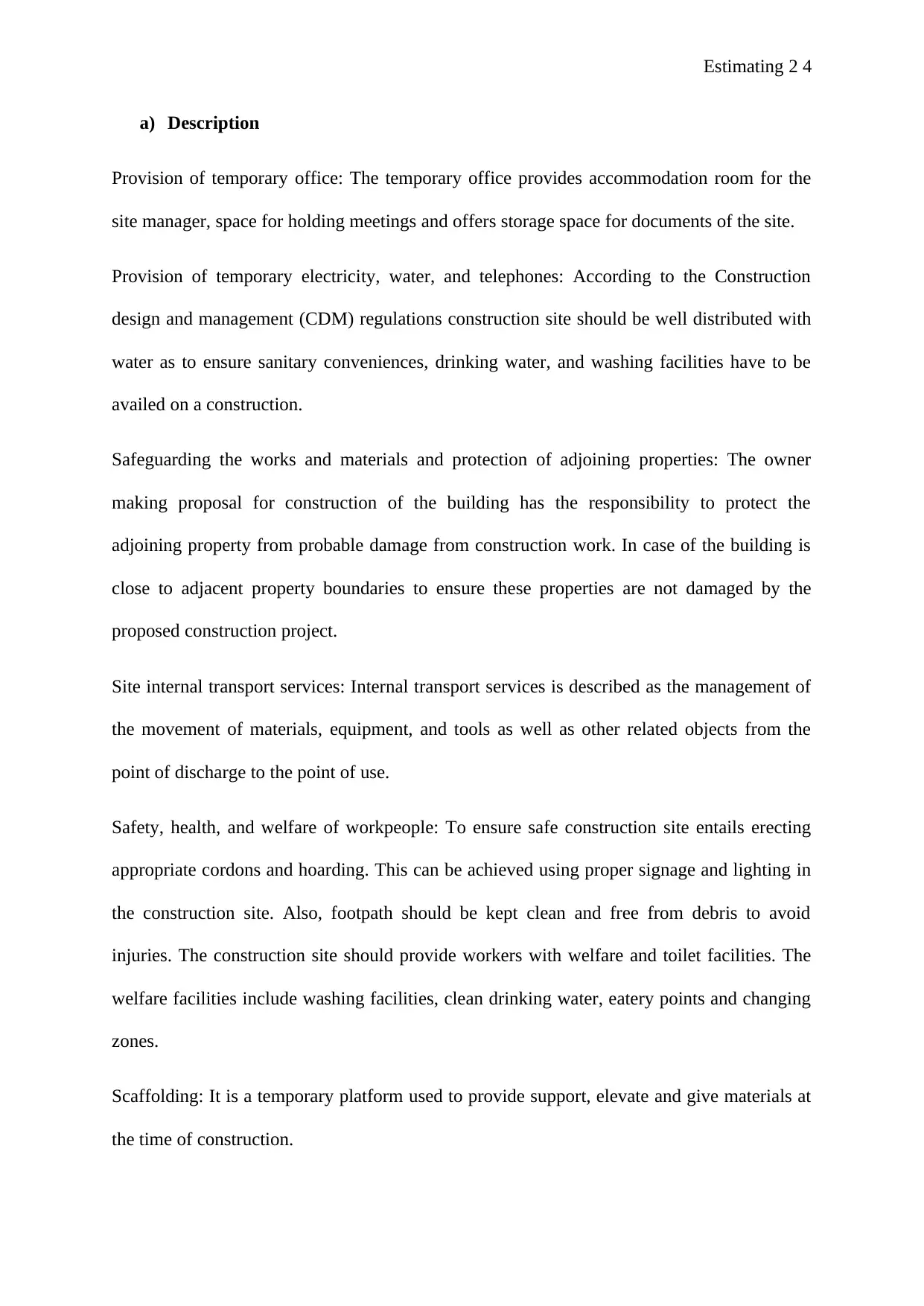
Estimating 2 4
a) Description
Provision of temporary office: The temporary office provides accommodation room for the
site manager, space for holding meetings and offers storage space for documents of the site.
Provision of temporary electricity, water, and telephones: According to the Construction
design and management (CDM) regulations construction site should be well distributed with
water as to ensure sanitary conveniences, drinking water, and washing facilities have to be
availed on a construction.
Safeguarding the works and materials and protection of adjoining properties: The owner
making proposal for construction of the building has the responsibility to protect the
adjoining property from probable damage from construction work. In case of the building is
close to adjacent property boundaries to ensure these properties are not damaged by the
proposed construction project.
Site internal transport services: Internal transport services is described as the management of
the movement of materials, equipment, and tools as well as other related objects from the
point of discharge to the point of use.
Safety, health, and welfare of workpeople: To ensure safe construction site entails erecting
appropriate cordons and hoarding. This can be achieved using proper signage and lighting in
the construction site. Also, footpath should be kept clean and free from debris to avoid
injuries. The construction site should provide workers with welfare and toilet facilities. The
welfare facilities include washing facilities, clean drinking water, eatery points and changing
zones.
Scaffolding: It is a temporary platform used to provide support, elevate and give materials at
the time of construction.
a) Description
Provision of temporary office: The temporary office provides accommodation room for the
site manager, space for holding meetings and offers storage space for documents of the site.
Provision of temporary electricity, water, and telephones: According to the Construction
design and management (CDM) regulations construction site should be well distributed with
water as to ensure sanitary conveniences, drinking water, and washing facilities have to be
availed on a construction.
Safeguarding the works and materials and protection of adjoining properties: The owner
making proposal for construction of the building has the responsibility to protect the
adjoining property from probable damage from construction work. In case of the building is
close to adjacent property boundaries to ensure these properties are not damaged by the
proposed construction project.
Site internal transport services: Internal transport services is described as the management of
the movement of materials, equipment, and tools as well as other related objects from the
point of discharge to the point of use.
Safety, health, and welfare of workpeople: To ensure safe construction site entails erecting
appropriate cordons and hoarding. This can be achieved using proper signage and lighting in
the construction site. Also, footpath should be kept clean and free from debris to avoid
injuries. The construction site should provide workers with welfare and toilet facilities. The
welfare facilities include washing facilities, clean drinking water, eatery points and changing
zones.
Scaffolding: It is a temporary platform used to provide support, elevate and give materials at
the time of construction.
Paraphrase This Document
Need a fresh take? Get an instant paraphrase of this document with our AI Paraphraser
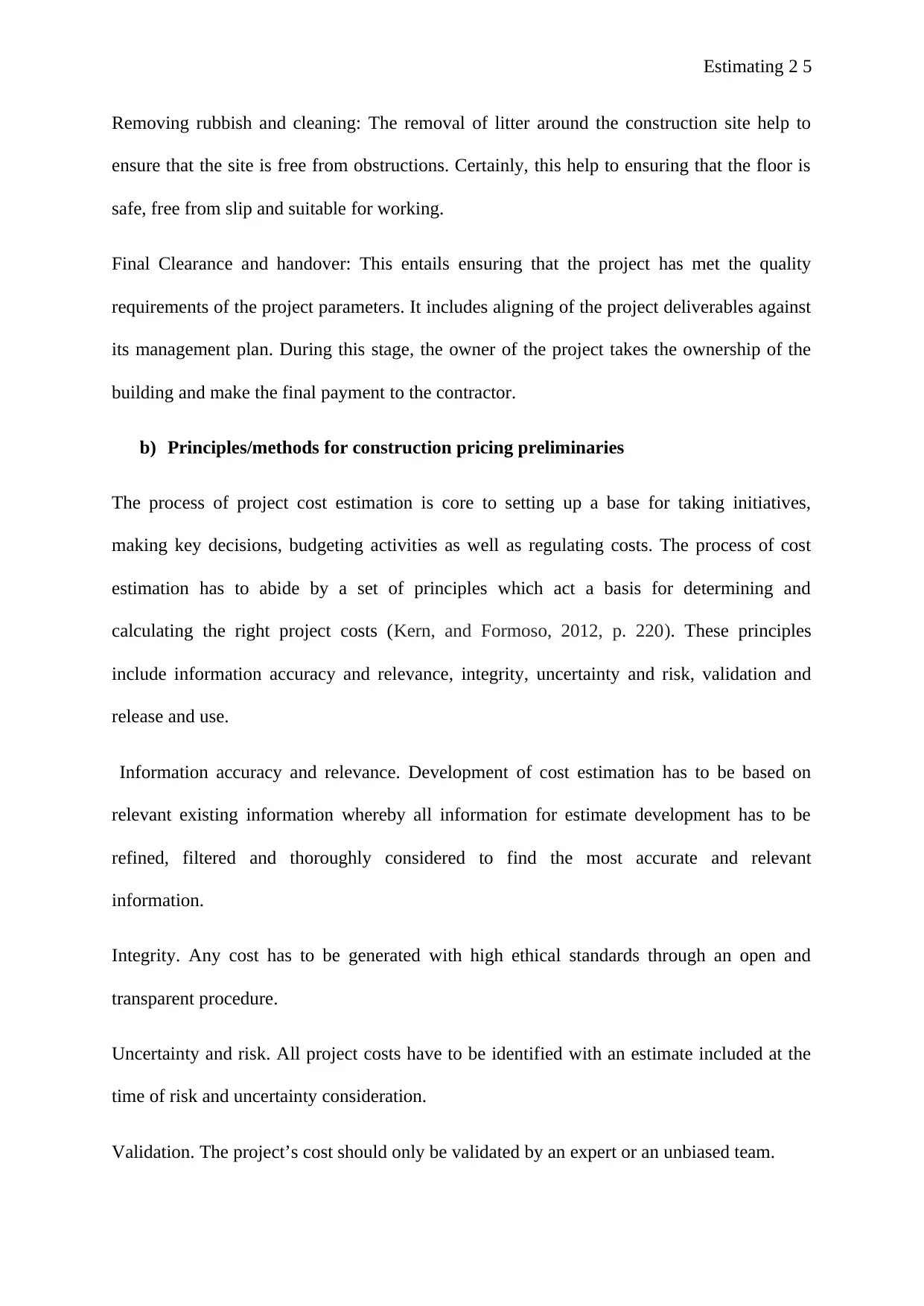
Estimating 2 5
Removing rubbish and cleaning: The removal of litter around the construction site help to
ensure that the site is free from obstructions. Certainly, this help to ensuring that the floor is
safe, free from slip and suitable for working.
Final Clearance and handover: This entails ensuring that the project has met the quality
requirements of the project parameters. It includes aligning of the project deliverables against
its management plan. During this stage, the owner of the project takes the ownership of the
building and make the final payment to the contractor.
b) Principles/methods for construction pricing preliminaries
The process of project cost estimation is core to setting up a base for taking initiatives,
making key decisions, budgeting activities as well as regulating costs. The process of cost
estimation has to abide by a set of principles which act a basis for determining and
calculating the right project costs (Kern, and Formoso, 2012, p. 220). These principles
include information accuracy and relevance, integrity, uncertainty and risk, validation and
release and use.
Information accuracy and relevance. Development of cost estimation has to be based on
relevant existing information whereby all information for estimate development has to be
refined, filtered and thoroughly considered to find the most accurate and relevant
information.
Integrity. Any cost has to be generated with high ethical standards through an open and
transparent procedure.
Uncertainty and risk. All project costs have to be identified with an estimate included at the
time of risk and uncertainty consideration.
Validation. The project’s cost should only be validated by an expert or an unbiased team.
Removing rubbish and cleaning: The removal of litter around the construction site help to
ensure that the site is free from obstructions. Certainly, this help to ensuring that the floor is
safe, free from slip and suitable for working.
Final Clearance and handover: This entails ensuring that the project has met the quality
requirements of the project parameters. It includes aligning of the project deliverables against
its management plan. During this stage, the owner of the project takes the ownership of the
building and make the final payment to the contractor.
b) Principles/methods for construction pricing preliminaries
The process of project cost estimation is core to setting up a base for taking initiatives,
making key decisions, budgeting activities as well as regulating costs. The process of cost
estimation has to abide by a set of principles which act a basis for determining and
calculating the right project costs (Kern, and Formoso, 2012, p. 220). These principles
include information accuracy and relevance, integrity, uncertainty and risk, validation and
release and use.
Information accuracy and relevance. Development of cost estimation has to be based on
relevant existing information whereby all information for estimate development has to be
refined, filtered and thoroughly considered to find the most accurate and relevant
information.
Integrity. Any cost has to be generated with high ethical standards through an open and
transparent procedure.
Uncertainty and risk. All project costs have to be identified with an estimate included at the
time of risk and uncertainty consideration.
Validation. The project’s cost should only be validated by an expert or an unbiased team.
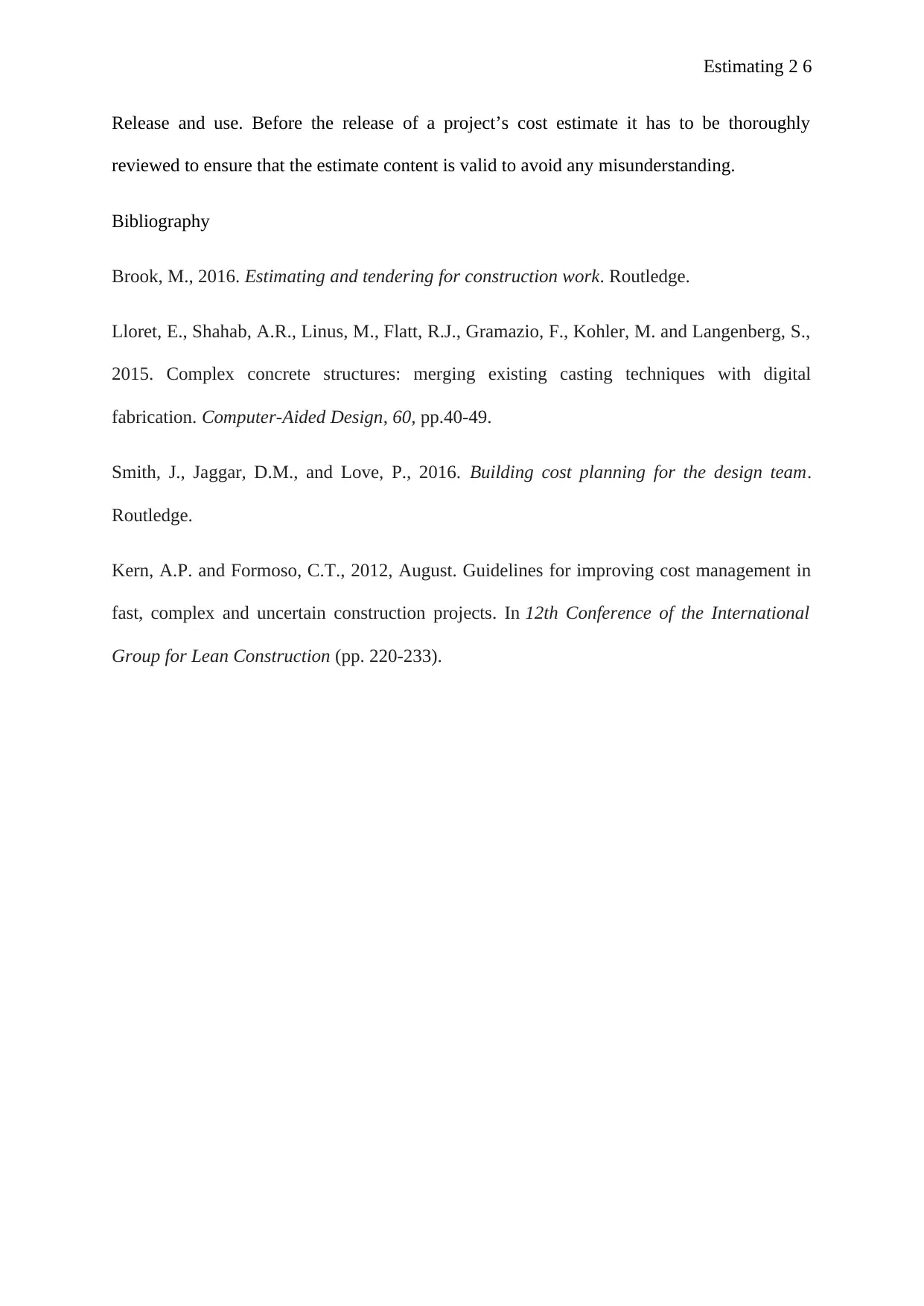
Estimating 2 6
Release and use. Before the release of a project’s cost estimate it has to be thoroughly
reviewed to ensure that the estimate content is valid to avoid any misunderstanding.
Bibliography
Brook, M., 2016. Estimating and tendering for construction work. Routledge.
Lloret, E., Shahab, A.R., Linus, M., Flatt, R.J., Gramazio, F., Kohler, M. and Langenberg, S.,
2015. Complex concrete structures: merging existing casting techniques with digital
fabrication. Computer-Aided Design, 60, pp.40-49.
Smith, J., Jaggar, D.M., and Love, P., 2016. Building cost planning for the design team.
Routledge.
Kern, A.P. and Formoso, C.T., 2012, August. Guidelines for improving cost management in
fast, complex and uncertain construction projects. In 12th Conference of the International
Group for Lean Construction (pp. 220-233).
Release and use. Before the release of a project’s cost estimate it has to be thoroughly
reviewed to ensure that the estimate content is valid to avoid any misunderstanding.
Bibliography
Brook, M., 2016. Estimating and tendering for construction work. Routledge.
Lloret, E., Shahab, A.R., Linus, M., Flatt, R.J., Gramazio, F., Kohler, M. and Langenberg, S.,
2015. Complex concrete structures: merging existing casting techniques with digital
fabrication. Computer-Aided Design, 60, pp.40-49.
Smith, J., Jaggar, D.M., and Love, P., 2016. Building cost planning for the design team.
Routledge.
Kern, A.P. and Formoso, C.T., 2012, August. Guidelines for improving cost management in
fast, complex and uncertain construction projects. In 12th Conference of the International
Group for Lean Construction (pp. 220-233).
⊘ This is a preview!⊘
Do you want full access?
Subscribe today to unlock all pages.

Trusted by 1+ million students worldwide

Estimating 2 7
1 out of 7
Related Documents
Your All-in-One AI-Powered Toolkit for Academic Success.
+13062052269
info@desklib.com
Available 24*7 on WhatsApp / Email
![[object Object]](/_next/static/media/star-bottom.7253800d.svg)
Unlock your academic potential
Copyright © 2020–2025 A2Z Services. All Rights Reserved. Developed and managed by ZUCOL.





